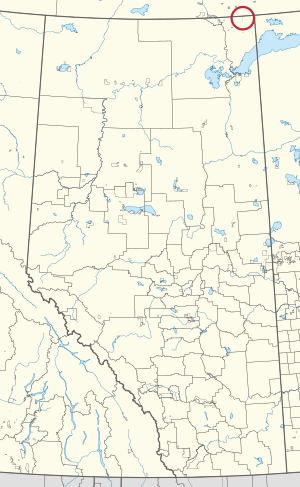Tsʼu Kué 196G facts for kids
Quick facts for kids
Tsʼu Kué 196G
Charles Lake
|
|
|---|---|
| Tsʼu Kué Indian Reserve No. 196G | |

Location in Alberta
|
|
| First Nation | Smith's Landing |
| Treaty | 8 |
| Country | Canada |
| Province | Alberta |
| Specialized municipality | Wood Buffalo |
| Area | |
| • Total | 42.7 ha (105.5 acre) |
Tsʼu Kué 196G is a special area of land in Alberta, Canada. It is known as an Indian reserve. This land belongs to the Smith's Landing First Nation. It is located within a larger area called the Regional Municipality of Wood Buffalo.
Contents
What is Tsʼu Kué 196G?
Tsʼu Kué 196G is one of the lands set aside for Indigenous peoples in Canada. These areas are called Indian reserves. They are managed by the First Nations themselves. The name "Tsʼu Kué" is pronounced "Tsoo Kway". It is also sometimes called Charles Lake.
Location and Size of the Reserve
This reserve is found in the northern part of Alberta. It is a small piece of land, covering about 42.7 hectares. To give you an idea, a hectare is about the size of a football field. So, this reserve is roughly the size of 42-43 football fields. It is part of the vast Regional Municipality of Wood Buffalo.
Where is Tsʼu Kué 196G on the Map?
You can find Tsʼu Kué 196G in the province of Alberta. Alberta is one of Canada's western provinces. The reserve is located in a region known for its natural beauty and resources. It is near the border with the Northwest Territories.
The Smith's Landing First Nation
Tsʼu Kué 196G is home to some members of the Smith's Landing First Nation. This First Nation is an Indigenous group in Canada. They have a rich history and culture that has been passed down through many generations. Their traditional lands cover a large area in both Alberta and the Northwest Territories.
Understanding First Nations in Canada
First Nations are the original inhabitants of Canada. They have lived on these lands for thousands of years. There are many different First Nations groups across Canada, each with their own unique languages, traditions, and ways of life. They are self-governing, meaning they make decisions for their own communities.
How Treaties Shape First Nation Lands
The Smith's Landing First Nation is part of Treaty 8. Treaties are special agreements made between First Nations and the Canadian government. These agreements were signed a long time ago. Treaty 8, signed in 1899, covers a huge area of land in western and northern Canada. It set aside lands, like Tsʼu Kué 196G, for the First Nations people. These treaties are very important because they define the rights and responsibilities of both sides.
Life on an Indian Reserve
Life on an Indian reserve can vary greatly from one community to another. Reserves are places where First Nation members can live together and practice their culture. They often have their own schools, community centers, and health services. The people living on reserves work to keep their traditions alive and build strong communities for the future.
Governance and Community
The Smith's Landing First Nation has its own government, led by a Chief and Council. They are responsible for managing the affairs of the community. This includes things like education, housing, and economic development. They work to improve the lives of their members and protect their land and culture.
Protecting Culture and Heritage
For the Smith's Landing First Nation, places like Tsʼu Kué 196G are important for keeping their culture strong. They use these lands for traditional activities like hunting, fishing, and gathering plants. They also teach their children about their history, language, and customs. This helps to ensure that their heritage continues for future generations.
Images for kids


